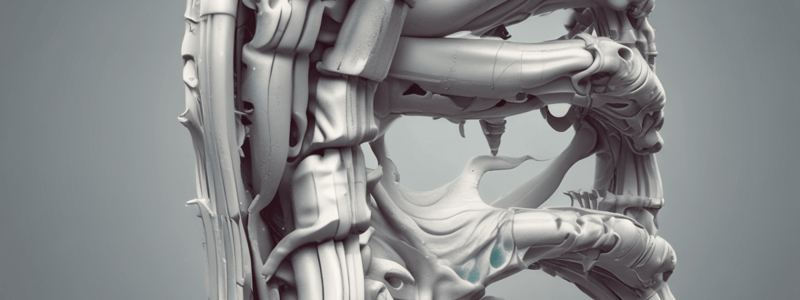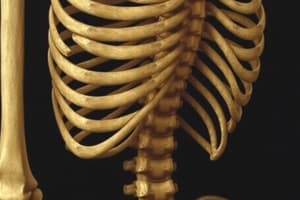Podcast
Questions and Answers
A column with 3 flexible curvatures has a resistance of R=10.
A column with 3 flexible curvatures has a resistance of R=10.
True (A)
A spinal column with normal curvatures has an index of 95% within normal limits of 94-96.
A spinal column with normal curvatures has an index of 95% within normal limits of 94-96.
True (A)
Exaggerated curvatures of the spinal column have a Delmas index higher than 94%.
Exaggerated curvatures of the spinal column have a Delmas index higher than 94%.
False (B)
Collagen concentrations are highest in the nucleus pulposus of the intervertebral disk.
Collagen concentrations are highest in the nucleus pulposus of the intervertebral disk.
The lamellae of the intervertebral disk are arranged in parallel instead of concentric rings.
The lamellae of the intervertebral disk are arranged in parallel instead of concentric rings.
Adjacent collagen fiber rings within the annulus of the disk have the same orientation.
Adjacent collagen fiber rings within the annulus of the disk have the same orientation.
Sharpey's fibers connect the annulus fibers to the nucleus pulposus in the intervertebral disk.
Sharpey's fibers connect the annulus fibers to the nucleus pulposus in the intervertebral disk.
A spine with attenuated curvatures (static type) has an index greater than 96%.
A spine with attenuated curvatures (static type) has an index greater than 96%.
Collagen fibers in the intervertebral disk run nearly vertically to effectively resist sliding and torsion forces.
Collagen fibers in the intervertebral disk run nearly vertically to effectively resist sliding and torsion forces.
The greater the ratio between disk thickness and height of the vertebral body, the less mobility is expected.
The greater the ratio between disk thickness and height of the vertebral body, the less mobility is expected.
Torsional forces become relevant because fibers in all layers become taut during twisting movements.
Torsional forces become relevant because fibers in all layers become taut during twisting movements.
Distraction forces are associated with flexion, extension, and lateral flexion of the spine.
Distraction forces are associated with flexion, extension, and lateral flexion of the spine.
The closer the nucleus position to the center, the lower the hydrostatic pressure within the intervertebral disk.
The closer the nucleus position to the center, the lower the hydrostatic pressure within the intervertebral disk.
Compression force from body weight and muscle contraction raises hydrostatic pressure in the nucleus pulposus.
Compression force from body weight and muscle contraction raises hydrostatic pressure in the nucleus pulposus.
Sliding and torsion forces are produced during vertical plane movements of the spine.
Sliding and torsion forces are produced during vertical plane movements of the spine.
Increased tension in the annulus of the intervertebral disk promotes radial expansion of the nucleus.
Increased tension in the annulus of the intervertebral disk promotes radial expansion of the nucleus.
The pressure within the nucleus reinforces the peripheral annulus fibrosus.
The pressure within the nucleus reinforces the peripheral annulus fibrosus.
Pressure in the Nucleus Pulposus disc is small when holding a load in front of the body.
Pressure in the Nucleus Pulposus disc is small when holding a load in front of the body.
Lifting a load with knees flexed exerts more pressure on the lumbar disc than lifting with knees straight.
Lifting a load with knees flexed exerts more pressure on the lumbar disc than lifting with knees straight.
Sitting in an erect position produces greater disc pressure compared to sitting in a forward-slouched position.
Sitting in an erect position produces greater disc pressure compared to sitting in a forward-slouched position.
The vertebral column contains 23 pairs of apophyseal joints.
The vertebral column contains 23 pairs of apophyseal joints.
Each apophyseal joint is formed by articulation between opposing facet surfaces.
Each apophyseal joint is formed by articulation between opposing facet surfaces.
Horizontal facet surfaces favor axial rotation.
Horizontal facet surfaces favor axial rotation.
Vertical facet surfaces favor lateral flexion.
Vertical facet surfaces favor lateral flexion.
Most apophyseal joint surfaces are oriented strictly horizontally or vertically.
Most apophyseal joint surfaces are oriented strictly horizontally or vertically.
Local muscle actions have no influence on the predominant motion at each spinal region.
Local muscle actions have no influence on the predominant motion at each spinal region.
Flashcards are hidden until you start studying




